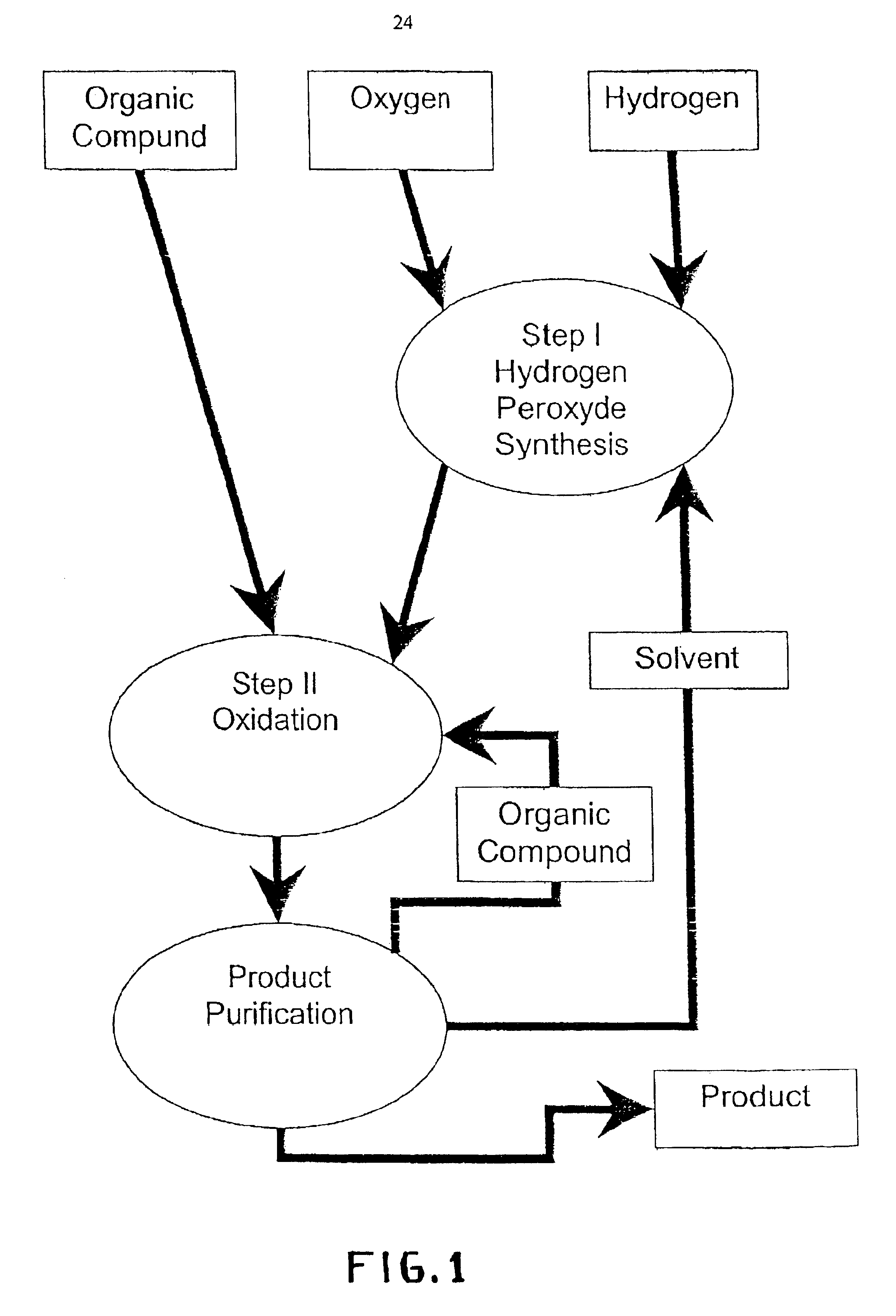Integrated process for selective oxidation of organic compounds
a selective oxidation and organic compound technology, applied in organic oxidation, inorganic chemistry, functional group formation/introduction, etc., can solve the problems of posing a serious safety hazard, oxidation process can be prone to explosive gas mixtures, and many significant problems faced by conventional oxidation processes
- Summary
- Abstract
- Description
- Claims
- Application Information
AI Technical Summary
Problems solved by technology
Method used
Image
Examples
example 1
A catalyst was prepared from a commercial resin functionalized with sulphonic groups (Lewatit.RTM. K2641 Bayer AG, non-halogenated macroporous resin, with an exchange capacity of 4.8 eq / l, pore diameter 70 nm, porosity 0.3 ml / g, and a specific surface area BET 35 m.sup.2 / g). Firstly the resin was washed three times with acetone, using equal volumes of solvent and resin. Next, a resin suspension (4 g) is prepared with 50 ml of methanol. To this suspension, a palladium (II) acetate solution (86 mg) in acetone (20 ml) is added drop by drop. The suspension was dried in a rotative evaporator under vacuum, the temperature of the bath was 45.degree. C. The solid obtained was air-dried at 110.degree. C. for 2 hours.
example 2
1.6 g of a catalyst, prepared as described in Example 1, are put inside an autoclave with 150 g of methanol and 24 ppm of HBr. The mixture was pressurized at 9.6 MPa(a) with nitrogen and stabilized at 40.degree. C. Then the reactor was feed with the gas reaction mixture H.sub.2 :O.sub.2 :N.sub.2 (3.6:46.4:50) with a total flow of 2500 mlN / min and the stirring was started up (1500 rpm) to initiate the reaction. After 2 h of the reaction a hydrogen peroxide concentration of 9.3 wt % was reached. The hydrogen peroxide selectivity was 80%.
example 3
A hydrogen peroxide solution, prepared as described in Example 2, was used in the epoxidation of 1-octene without any kind of previous purification. 1-octene (0.1 mol), methanol (55 ml) and a hydrogen peroxide solution was prepared as described in Example 2 (4.4 g) were heated at 333 K (approximatively 60.degree. C.). Then, 1 g of TS-1 catalyst (prepared as described in J. A. Martens, Ph. Buskens, P. A. Jacobs A. van der Pol, J. H. C. van Hooff C. Ferrini, H. W. Kouwenhoven, P. J. Kooyman and H. van Bekkum, Appl. Catal. A: General, 99, 71 (1993)) was added. The transformation of H.sub.2 O.sub.2 obtained was of 93% and the efficiency of H.sub.2 O.sub.2 was 90.5%, after 1.5 hours of reaction. From oct-1-ene converted the selectivity to epoxide was 50% and 50% to methyl-ethers.
PUM
| Property | Measurement | Unit |
|---|---|---|
| temperature | aaaaa | aaaaa |
| temperature | aaaaa | aaaaa |
| pressure | aaaaa | aaaaa |
Abstract
Description
Claims
Application Information
 Login to View More
Login to View More - R&D
- Intellectual Property
- Life Sciences
- Materials
- Tech Scout
- Unparalleled Data Quality
- Higher Quality Content
- 60% Fewer Hallucinations
Browse by: Latest US Patents, China's latest patents, Technical Efficacy Thesaurus, Application Domain, Technology Topic, Popular Technical Reports.
© 2025 PatSnap. All rights reserved.Legal|Privacy policy|Modern Slavery Act Transparency Statement|Sitemap|About US| Contact US: help@patsnap.com

